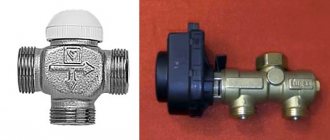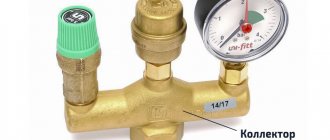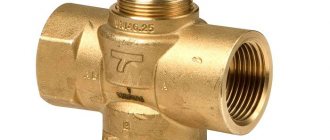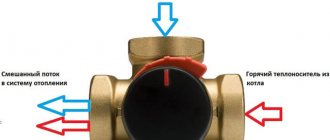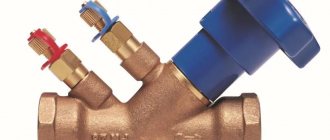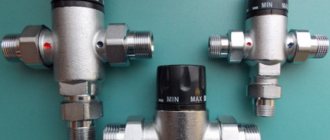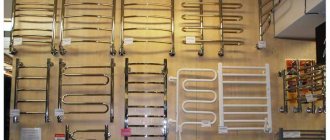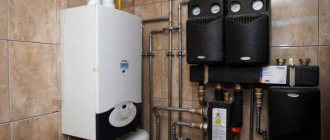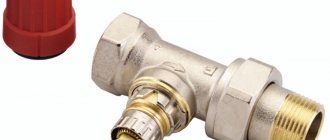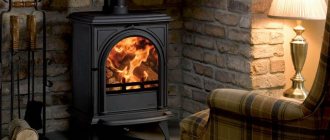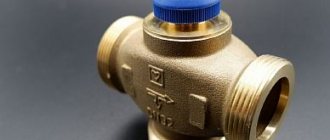In heating, water can reach 80-90°C. And if this is still normal for pipes with radiators, then for a heated floor this temperature is too high. To ensure normal standing on the floors, a three-way valve is used. Although it is not installed only for these purposes, it is indispensable in a system with almost any solid fuel boiler. Let's figure out what this mechanism is, what it is needed for and how to choose the right three-way valve for the heating and water supply system.
What is it and why is it needed
This is what a classic three-way valve for a heating system looks like.
As the name suggests, this valve has 3 strokes. You can even call it a tap, since it refers to shut-off and control valves. In appearance it is an ordinary tee, but inside its structure is much more complicated. Roughly speaking, it serves to change the temperature of the water. There are two methods: in the first, the return is mixed with the supply to lower the temperature; the second method, on the contrary, separates the flows, discharging hot water into the return line. This is useful in different cases:
- Warm floor . The return and heating supply are connected to the valve. Since the return is colder, water at a lower temperature is supplied to the floors. At the same time, the temperature of the rest of the heating remains the same.
- Temperature maintenance . For normal operation of almost any heating equipment, it is necessary that the return flow is not 60 degrees colder than the supply. Otherwise, the boiler will not last long. Therefore, the valve takes water from the supply and sends it to the return.
- Condensation protection . For the same reason. If water warmer than the dew point enters the heat exchanger, condensation begins to accumulate on it.
- Overheat protection . Modern boilers are equipped with various sensors. If it is, for example, a simple solid fuel boiler, it will continue to work even if it overheats. The three-way valve solves this problem.
- For piping an indirect heating boiler . To have hot water in the house, you can connect a boiler to the boiler. And then the water will be heated using heating. The three-way tap serves for uninterrupted supply of hot water. It opens when the water temperature in the boiler drops.
- When organizing a bypass . In some cases, it is necessary to direct water along an alternative path - a bypass. For example, for more efficient heating. The easiest way to do this is through a three-way valve. It will open and close at the right time.
But why install a valve when you can simply reduce the temperature? The question seems logical, but in fact, in conventional boilers at low temperatures, the heat exchanger quickly fails. A condensing boiler is better suited for this mode of operation, but their price is much higher. Therefore, it is better and easier to install a three-way valve.
As you can see, there are quite a lot of ways to use it. In some cases, it is used to improve the energy efficiency of the system. In others, it is an indispensable device for connecting equipment.
Boiler repair
In case of leakage, we repair fire tube boilers in the following sequence:
- We study the documentation and diagrams of the device.
- We search for the problem area and localize it.
- We clean the surface near the crack to bare metal to a width of 15-20 mm.
- We carry out welding work at ambient temperatures above +50C. We use electrodes with a thickness of 2.5 mm or 3 mm. We weld the seam from the side of the drum 2-4 mm larger than from the pipe. The welding direction is from the middle of the crack to the edges using two welding machines simultaneously.
- We clean the seam until it shines and look at its quality. If necessary, we eliminate deficiencies: uncooked areas and shells.
- We test the boiler.
Fire-tube water-heating boilers are used in boiler houses, for heating private households, in industry and other areas.
Sometimes in the construction of fire-tube boilers, due to improper operation, it becomes necessary to replace the damaged section. For these purposes, the gas-flame method is used. In this case, the dimensions of the damaged part must be at least 200 mm or the diameter of the pipe. First, they localize the area, then cut it out with a grinder until the thickness and properties of the metal are preserved, after which they clean and weld a patch made of steel of the same composition.
Fire-tube water heating boilers are used in boiler houses, for heating private households, in industry and other areas. This is due to their high heating efficiency and economical fuel consumption, reliability and ease of operation. The design of fire tube boilers is relatively simple, so they can be easily repaired even independently without the involvement of specialists.
Design and principle of operation of a three-way valve in a heating system
To make it easier for you to understand the principle of operation, I suggest considering this diagram:
Sectional design of a three-way valve.
When it is necessary to achieve a certain temperature, the rod rises, opening the duct. This is reminiscent of the operating principle of shut-off valves. And the mechanism itself is called a saddle mechanism. Instead of a rod, a ball or a rotating sector is sometimes used. Exactly the same as in conventional ball valves. This mechanism is called a rotary mechanism. They can be depicted in the diagram as follows:
I’ll talk about what exactly controls the rod or ball a little later. For now, let's look at each type. Let's start with the mixing valves:
As you can see, hot water enters from the left and cold water from below. The rod rises when necessary, allowing the two streams to be mixed.
And this is what the operation of a separating valve looks like. Here, on the contrary, hot water enters from the right, and can exit to the left or down. If the temperature is normal, the rod rises. If higher temperatures are required, the rod is lowered, sending hot water downwards. That is, in the opposite direction.
From the instructions for the VMR type valve from Mut International.
Typically, thermomixing and separation valves do not close completely. But the switches, as you can see, close one of the pipes and open the other. In this case, no mixing or separation occurs.
Cross-section of a typical three-way valve.
Functional application of the device
If we consider the flow switching mechanism from the point of view of possible functionality, it should be noted that the devices differ in their operating principle:
- Dividing.
- Switching.
- Mixing.
The separation principle of operation involves dividing the flow, directing it into two circuits.
The switching function provides for the organization of switching between devices that consume thermal energy. For example, switching between the DHW and heating circuits of a double-circuit gas boiler.
Switching functionality of the valve (classical diagram): P – primary circuit; B – secondary circuit; 1, 2 – direct transport channel; 3, 2 – corner transport channel
The switching functionality allows you to organize efficient switching between various devices that generate thermal energy:
- water heaters;
- heat pumps;
- solar panels, etc.
Another function of a three-way valve for a domestic gas boiler is mixing. It allows you to organize controlled mixing of working fluid flows (mixing return flow into the heated coolant).
To do this, it is enough to install a three-way valve on the return pipe of the heating system.
Mixing functionality of the valve (classical diagram): P – primary circuit; B – secondary circuit; 2, 1 – direct transport channel; 2, 3 – corner transport channel
Now, after a brief acquaintance with the design details of the device, we can consider the features of checking the operation of a three-way valve installed in the gas boiler circuit.
How to choose a three-way valve for a private home heating system
Now you know for what purposes certain types of valves are used. But this is not the only selection criterion, because the valves have several ways of regulating the temperature and different throughputs. Yes, and the material of manufacture may differ. Let's look at this in more detail.
Temperature control method
Manual.
Let's start with manual adjustment. Here the rod is connected to a valve or handle; under them there are marks, with the help of which the temperature is regulated. This is the simplest and cheapest method, so some consider it more reliable. But I believe that it all depends on the company: if the valve is of high quality, then with automatic adjustment it will work no less than with manual adjustment.
| Advantages | Flaws |
| Low price compared to other types of valves | You have to independently react to all changes in environmental conditions |
| Works without electricity connection | The heating circuit warms up unevenly |
Thermostatic.
If a thermostat is built into the design, such a valve is called thermostatic. Usually it is configured only once. Then he himself selects the position of the rod based on temperature fluctuations. A heat-sensitive liquid or gas is responsible for this: when the temperature rises, they expand and begin to move the rod. Such valves are either electronic or mechanical. A three-way valve with a thermostat is much more convenient than a manual one, since it operates automatically, but it also costs more.
| Advantages | Flaws |
| Automatic temperature control | High price compared to manual valves |
| Uniform heating of the heating circuit | |
| Mechanical models work without electricity |
With servo drive.
Three-way valves with electric drive are considered the most accurate. They have a built-in thermostat, but control occurs using an electronic unit that operates on a servo drive. When the temperature changes, the thermostat sends a signal to the controller. And now he controls the drive, raising or lowering the rod.
| Advantages | Flaws |
| Does not require human participation in temperature control | High price |
| Highest precision of any type of three-way valve | Electricity addiction |
| The highest quality and uniform heating heating | Increased energy consumption compared to electronic thermostatic valves |
I think it's better to go with the middle option. Manual adjustment is inconvenient, and the motorized valve is expensive. And such precision is rarely required in everyday life.
Material of manufacture
The durability of the product depends on the material used to make the case. I want to say right away that sometimes there are valves made of silumin. Although they are much cheaper, I do not recommend paying attention to them. And there are many other reliable materials:
- Black carbon steel valves are durable and relatively inexpensive. Unfortunately, they are susceptible to corrosion, so they are usually plated with nickel or chrome. Stainless steel is also often used, but such products are more expensive.
- Cast iron is strong, durable and does not corrode. But usually these are old-style valves, since more advanced materials are now used.
- The most popular are products made of brass and bronze. These are durable, strong and stainless materials. They cannot be used in industrial conditions where temperatures exceed 200 degrees, but they are ideal for domestic needs. I advise you to choose just such three-way valves; if the material is not indicated in the characteristics, it can always be identified by its characteristic color and texture.
I would also like to say something about ceramics. It is practically not used as a material for the body. But internal parts are often made from it. This is due to the fact that ceramics are not affected by chemicals. And it is also durable.
How to select and connect to the system the most important element - a security group
Temperature range and operating pressure
When choosing a three-way valve, the temperature adjustment range should also be taken into account. For example, a thermomixer for heated floors is usually set to 30-40°C. Although this range is the most comfortable for obtaining hot water. The maximum pressure that the valve can withstand also varies. Some models can withstand up to 16 bar. Although usually in domestic conditions more than 6 bar is not required. In general, the operating pressure values for these devices are regulated by GOST 26349-84.
Other
Of course, do not forget that three-way valves have different diameters of connecting pipes. The most common sizes for domestic use are 1 and ¾ inches. The thread can be internal or external.
The number of liters that passes through the valve per hour depends on the throughput indicators. The choice should be made so that the valve coefficient is slightly higher than the calculation result. For example, if the system flows 2 m³ per hour, a valve with a capacity of 2.5 m³ per hour should be selected.
But the throughput varies depending on whether the valve is fully open or slightly open. The ratio of these indicators is called the dynamic range of regulation. The higher the ratio, the better the throughput is maintained. The best odds are considered to be 100:1, but they are quite rare. The most common indicators are 50:1 or 30:1; valves with such indicators can be safely taken.
The best known manufacturers and models: characteristics and prices
Now I want to talk about the most popular and reliable three-way valves to make it easier for you to choose the right model.
TIM
Manufacturer from China. It offers fairly high-quality products for heating and water supply at a relatively low price.
| Photo | Model | Specifications | Peculiarities | Cost, rub. |
| (ZEISSLER) BL3110C04 | Material: brass Temperature range: 35-60 Operating pressure: 2-5 bar Diameter: 1 inch | Mixing, for heating and hot water supply | 2 300-3 000 | |
| BL8803 | Material: brass Temperature range: 38-60 Operating pressure: 3-10 bar Diameter: ¾ inch | Mixing, external connection via American connection | 2 800-3 500 | |
| BL8804A | Material: brass Temperature range: 38-60 Operating pressure: 3-10 bar Diameter: 1 inch | Mixing, electrically driven | 2 000-2 600 |
Esbe
This Swedish company produces various models of valves and controllers. I believe that the products from this company are of the highest quality. Although expensive.
| Photo | Model | Specifications | Peculiarities | Cost, rub. |
| VTA321 | Material: brass Temperature range: 35-60 Operating pressure: 2-10 bar Diameter: ¾ inch | Mixing, for heating and hot water supply | 6 000-6 500 | |
| VTA372 | Material: brass Temperature range: 20-55 Operating pressure: 3-10 bar Diameter: 1 inch | Mixing, high throughput | 7 000-8 000 | |
| VTC511 | Material: cast iron Temperature range: 60-75 Working pressure: 3-10 bar Diameter: 1 inch | For solid fuel boilers | 8 000-9 000 |
STOUT
Joint production of Russia, Italy, Spain and Germany. The products are perfectly adapted to Russian conditions.
| Photo | Model | Specifications | Peculiarities | Cost, rub. |
| SVM-0120-164325 | Material: brass Temperature range: 20-43 Operating pressure: 3-10 bar Diameter: 1 inch | Mixing, for heating and hot water supply | 4 500-5 000 | |
| SVM-0125-186520 | Material: brass Temperature range: 30-65 Operating pressure: 3-10 bar Diameter: ¾ inch | Mixing, for heating | 4 000-4 300 | |
| SVM-0120-256025 | Material: brass Temperature range: 35-60 Operating pressure: 3-10 bar Diameter: 1 inch | Mixing, high throughput | 5 200-5 800 |
WATTS
One of the largest manufacturers of heating equipment in Europe. Huge range of products.
| Photo | Model | Specifications | Peculiarities | Cost, rub. |
| Aquamix 61C | Material: brass Temperature range: 32-50 Operating pressure: 3-10 bar Diameter: ¾ inch | Mixing, for DHW | 5 200-5 700 | |
| Aquamix 63C | Material: brass Temperature range: 25-50 Operating pressure: 1-10 bar Diameter: ¾ inch | Mixing, for heated floors | 5 500-6 000 | |
| V3GB Watts Classic | Material: brass Temperature range: 20-50 Operating pressure: 3-10 bar Diameter: 1 inch | Mixing, electrically driven | 12 500-14 000 |
Rules for installing fittings
Typically, the manufacturer indicates the movement of water flow with arrows on the body of a three-way valve. Using these guidelines, you can determine the type of valve. Connection to the system occurs as indicated by the arrows. The installation location should be convenient for subsequent adjustments or replacement in case of malfunction. Both return and supply are suitable for this. But read the instructions carefully, since not all valves can be installed for supply.
Since most of the valves inside are made of ceramic, they do not handle dirty water well. Therefore, it is better to install a filter in front of the valve. If this is not done, the device may become clogged. In some cases, it is enough to clean it, but sometimes even this does not save. Therefore, you should not skimp on filters.
The electric drive should not be located at the bottom, and mechanical thermostatic mixers are also not recommended to be installed this way, only vertically. But I can say from my own experience that in some cases this is possible. And reviews from some owners confirm this.
Principle of operation
The operating principle of a fire tube boiler is to transfer thermal energy from burning fuel to the coolant. The vaporization process occurs at a temperature of 115˚C and a pressure of 0.7 kgf/sq.cm. The fuel is burned in a combustion chamber, which is cooled with water, except for the front side. When water is heated, steam formation occurs; the steam is accumulated in a suitable reservoir connected to the heating system. Exhaust gases are removed through a bundle of pipes.
Photo source: pudeb.com
Fuel for boilers can be varied: liquid, solid and gaseous. The equipment is a gas-tube installation with flame tubes in which burning fuel circulates. The flame tubes have a low-pressure gas burner and forced pressurization. The flame tube is a kind of combustion chamber within which the supplied fuel is burned.
Layout diagrams of a three-way valve in a heating system
The simplest scheme in a system with a solid fuel boiler. Purpose: protection against condensation and overheating, maintaining the temperature in the heating circuit.
Heating scheme with electric boiler and heated floors. Hydrocollectors are used to distribute heated floors into several circuits.
Use in piping using an indirect heating boiler, which allows organizing hot water supply with a single-circuit boiler.
Types of fire tube boilers
Fire tube steam boilers are divided into the following types according to the type of heating of the coolant:
- steam, in which steam accumulated in a separate special tank is used for heating;
- water heating systems that use water to heat the coolant; the use of steam is unacceptable due to the need to prevent overheating and deformation of the walls of the boiler body.
Diagram of a water-heating fire-tube boiler
How to check a three-way valve for functionality
First of all, an external inspection should be carried out: there should be no cracks in the plastic and metal casing. As for the regulator, it should turn smoothly in all directions. To check the thermal head, it needs to be heated. For example, a hair dryer. In this case, the rod should move in accordance with the indicators. If the valve has an electric drive installed, you can check its functionality using a tester, but to do this you will have to disassemble the electric drive.
Conclusion
Three-way valves only resemble a tee in appearance. Their design is much more complex, and their applications are quite diverse. Choose a valve responsibly; consider only models from well-known, reputable manufacturers; fortunately, there are plenty of them. And then this small but very important device will work for many years without causing problems.
Boiler room equipment
